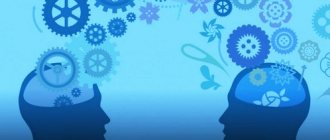Emotional intelligence (EQ, Emotional Quotient, Social Intelligence) is a concept close to IQ (intelligence quotient), but in which the basis is not a person’s intellectual abilities, but his ability to manage his own emotions and empathy for other people. The second common name for the same concept is social intelligence.
The Emotional Intelligence Assessment measures a range of aspects of emotional intelligence to predict your ability to understand and manage your emotions and predict the emotional reactions of others.
When used in testing applicants for a job, an EQ test can include a wide range of test questions, usually presented in the form of questionnaires or mini-cases - scenarios of specific work situations in the workplace. Each situation involves 2 or more parties who interact in some way in the workplace (colleagues, manager and subordinate, employee and client, etc.).
Emotional intelligence tests are widely used at work where a lot of communication is required every day - in call centers of banks and mobile operators, for the positions of operator, sales and customer support managers, as well as for managers at all levels, including the Russian government at the federal level. and regional level. For managers, the ability to recognize emotions and empathize is even more important - it is part of the required skills for effective management. Social intelligence tests are included in the Leaders of Russia tests, and specifically in the tests for managerial potential of the Leaders of Russia competition. You can learn more about the tests of the Leaders of Russia competition in our special articles How to prepare for the competition Leaders of Russia 2019-2020 and Testing for the managerial potential of the Leaders of Russia competition
The competition Leaders of Russia and Leaders of Russia.Politics in 2021 uses separate blocks of tests for emotional intelligence. They are designed to assess how experienced a leader you are, who can understand the emotions of other people (subordinates, colleagues, senior managers), and how effectively you are able to manage your emotions. These are quite long tests, lasting 30-40 minutes, the questions of which may be ambiguous.
The most popular and trustworthy tests for emotional intelligence are the Hall, Lucin, Guilford tests and the Mayer-Salovey-Caruso MSCEIT test, which has 144 control questions. The developers of such tests are all leading companies in the field of hr technologies: SHL, Talent Q, ECOPSY and others.
Background of the issue
In 1920, E. Thorndike formulated a three-component model of intelligence, including the ability to understand and operate with ideas (abstract intelligence), concrete objects (mechanical intelligence) and people (social intelligence). This is how the concept of social intelligence was introduced into psychology, which was defined by E. Thorndike as “the ability to understand people and manage them, to act wisely in human relations.” Other leading experts in the field of psychology of intelligence, such as C. Spearman, D. Wexler, P. Vernon, J. Guilford, also argued in one form or another that understanding the behavior of other people and oneself should be distinguished as a separate intellectual ability. Among the more modern approaches of this kind, one can name the theory of multiple intelligences by H. Gardner, within which intrapersonal and interpersonal intelligence are distinguished.
Unfortunately, constructs associated with abilities in the field of understanding social interactions and intrapersonal processes have turned out to be complex in terms of their operationalization and differentiation from traditional forms of intelligence. Thus, based on data on the significant intersection of social intelligence with verbal abilities, L. Cronbach came to the conclusion that research in this area is unpromising. However, in the last decade, more and more works have begun to appear in the scientific and popular literature devoted to one of these abilities—emotional intelligence (EI). In a broad sense, emotional intelligence includes the ability to recognize, understand and manage emotions; This refers to both the subject’s own emotions and the emotions of other people. Widespread interest in EI indicates that this concept corresponds well to the ideas of everyday psychology, intuitively seems promising for solving applied psychological problems, and expands existing ideas about the diversity of human abilities, thereby enriching scientific psychology.
Teen EQ Analysis
The test was created for the most emotionally unstable social group. During adolescence, all events are experienced most acutely. If at this time the foundation for the formation of a healthy emotional sphere is not laid, a person may face serious psychological problems in the future.
The technique consists of 20 questions divided into 3 topics: reactions, responsibility, situations. For each question there are 4 possible answers to choose from. For each answer a certain number of points is given. At the end, you need to add up all the points and see what range the number falls into.
Go to test
General understanding of emotional intelligence
Research on emotional intelligence appeared in scientific articles in the early 1990s. This concept has gained well-deserved popularity and attracts many researchers. The reasons for this popularity are related both to attempts to assess the more holistically adaptive abilities of an individual through his ability to emotionally interact with others, and to the ability to predict the success of behavior in various types of social activity.
Initially, the concept of “emotional intelligence” was associated with social intelligence. It appeared precisely in the context of the development of problems of social intelligence by such researchers as J. Guilford, H. Gardner and G. Eysenck. However, at the present stage, research into emotional intelligence is a completely independent area. We can agree with the opinion of D.V. Ushakov that emotional intelligence, although closely related to social intelligence, has its own specifics. Therefore, these two constructs can be conceptualized as overlapping domains. The publication of D. Goleman's book “Emotional Intelligence” in 1995 brought popularity to the view of emotions as an area of intelligence. The term “emotional intelligence” was first introduced into psychology by D. Meyer and P. Salovey. They defined emotional intelligence as the ability to perceive and express emotions, assimilate emotions and thoughts, understand and explain emotions, and regulate the emotions of oneself and others.
In 1990, they developed one of the first and best known models of this construct. At the same time, they began developing a methodology for studying emotional intelligence. Over time, based on the data obtained, they refined and improved the theoretical model. The methodology also changed until MSCEIT V2.0 (The Mayer–Salovey–Caruso Emotional Intelligence Test) was created in 2002, a standardized test for measuring emotional intelligence. Work on the study of emotional intelligence precisely within the framework of the theory of Meyer, Salovey and Caruso is now actively continuing at Yale University under the leadership of Peter Salovey.
Richard Roberts, Gerald Matthews, Moshe Zaidner and Dmitry Lyusin, in their detailed review of research on emotional intelligence, identify two main models of this construct, on the basis of which they propose methods for studying it. Mixed models of emotional intelligence interpret it as a complex mental formation that has both a cognitive and personal nature. These models incorporate cognitive, personality, and motivational traits, making them closely related to real-life adaptation. All models in this approach differ only in the set of included personal characteristics. Emotional intelligence is measured directly using self-report questionnaires, just like regular personality questionnaires. For example, Reven Bar-On distinguishes between interpersonal and intrapersonal emotional intelligence, and in his EQ-i (Bar-On Emotional Quotient Inventory) questionnaire he also includes scales for adaptation, stress management and general mood.
As noted by R. Roberts, J. Matthews, M. Seidner and D. Lucin, each of these two approaches to understanding emotional intelligence has its own strengths and weaknesses, which are most strongly manifested in the proposed research methodologies. For example, when evaluating methods based on mixed models, the question arises about a person’s ability to adequately assess and manage their emotions. Significant and high correlations between the scales of methods for emotional intelligence and the scales of personality questionnaires indicate that these methods measure various aspects of emotional intelligence. It is even more likely that these techniques merely measure individual contributions to emotional adjustment. Does emotional intelligence relate to intelligence as a general cognitive ability? This issue was discussed in the works of Meyer and Salovey, in the works of H. Gardner and in relation to social intelligence - in the work of D. Ushakov. Meyer and Salovey believe that emotional intelligence is closely related to cognitive intelligence, since they postulate the unity of affect and intelligence, which corresponds to the Russian traditions of the school of L. S. Vygotsky and S. L. Rubinstein. Ushakov also proposes a similar solution, believing that “social intelligence is on a par with other types of intelligence, forming together with them the ability for a higher type of cognitive activity - generalized and indirect.” Gardner believes in multiple intelligences. However, here it is appropriate to recall the existing ideas about the relationship between creativity and intelligence, more precisely, psychometric intelligence, which measures only those cognitive abilities that are included in the test model. As is known, the ratio of intelligence and creativity is of a threshold nature. Up to a certain value (average values), creativity is closely related to intelligence indicators; further it does not depend on the growth of intellectual abilities (with very high intelligence indicators, creativity can remain at very average values). We see the same attitude when studying the model of the mind - the ability to understand the mental states of oneself and another. An average level of intelligence is necessary, but not sufficient for the development of this ability, which is especially evident when studying autistic people with average and above average intelligence.
Methods based on ability models have good criterion validity and measure certain constructs that are different from all abilities and personal factors already identified in psychology. However, it remains unclear how emotional intelligence relates to these already identified constructs. Scoring is also a big question, since in the vast majority of methods it is based on consensus and expert assessments, which does not exclude conformity to social norms. However, such conformity is also characteristic of the development of other tests, including tests of intellectual abilities.
Of no less interest is the identification of the constructs underlying emotional intelligence and their measurement using a unified methodology. R. Roberts, J. Matthews, M. Seidner and D. Lucin offer a set of such constructs in relation to the role of emotional intelligence in adaptation and provide a list of methods and individual scales for measuring them. These include constructs such as temperament, information processing, confidence in one's emotional competence, and emotional knowledge and skills.
Daniel Goleman EQ Test
American psychologist Daniel Goleman has his own, different from others, view of measuring EQ. In his technique, he does not use direct questions, but asks the subject to try on one of 10 situations and try to predict his actions.
The situations are very different: a bad grade at school, unexpected shaking on a plane, a quarrel with a loved one. There are 4 behavior options to choose from in each of them. However, it remains a mystery to me how the author interprets the subject’s choice.
Go to test
Measurement problem
Thus, two main approaches to measuring EI can be distinguished. There are heated discussions around them in modern literature. Critics of the use of “objective” tests, consisting of items with one correct answer, similar to traditional intelligence tests, point out that the main difficulty with this approach is the lack of a convincing basis for determining the correct answer. For example, on what basis can one say what emotion is experienced by a character in a story or a person depicted in a photograph? To answer questions of this kind, it is proposed to use the following approaches: - expert assessments (but many authors believe that there is no convincing criterion for selecting experts in this field), - assessments of the majority of subjects (but this contradicts the very idea of tests of intelligence and abilities, especially in the case of difficult tasks, which a minority of the sample should be able to cope with), is the opinion of the developers of test tasks, for example, actors imitating emotions when creating test material, or artists creating images with certain emotions (but it is doubtful that actors or artists accurately enough depict emotions, in addition, there is a high probability that they exaggerate and stereotype them, which reduces the ecological validity of the test material). The problem of choosing the correct answer remains unsolved, while different methods of solving it using the same test material often give results that are poorly consistent with each other.
Another methodological approach to measuring EI is to use questionnaires. Its main drawback is its reliance on self-report, which contradicts the attempt to measure EI as one of the types of intellectual abilities. One of the problems with using EI questionnaires is that they tend to correlate weakly with intelligence tests and much more closely with personality questionnaires. In this regard, critics have suggested that EI questionnaires measure nothing more than some combination of personality traits. A more detailed analysis of the psychometric properties of techniques representing these two approaches to measuring EI shows that they are weakly correlated with each other, and the patterns of their correlations with techniques that measure other constructs do not coincide sufficiently. Therefore, it can be assumed that these two types of techniques measure either quite different constructs altogether, or, at best, different aspects of EI. It seems that in the current situation, it is optimal to use simultaneously different methodological approaches for assessing EI in practical and research work.
EQ test on the Vikium platform
This test, unlike the previous method, will not force you to delve into yourself. All you need to do is look at photographs of people and choose from a list the emotions that go with them. There are 7 of them in total: surprise, anger, joy, disgust, fear, contempt, sadness.
The technique assesses the ability to read other people's emotions. People who have it well developed are able to communicate delicately and flexibly, unlike insensitive people. The online test will show how correctly you have identified emotions and will highlight the most problematic ones.
Go to test
The most well-known methods in Russia for measuring emotional intelligence
The following methods for measuring emotional intelligence are currently known:
Hall test
The most widely used method is M. Hall, which was introduced by E. P. Ilyin. It is almost identical to the EQ technique. The technique consists of 30 statements, divided into 5 scales:
- emotional awareness,
- managing your emotions,
- self-motivation,
- empathy,
- recognizing other people's emotions.
The answer to each statement requires a 6-point scale: from –3 – “completely disagree” to +3 – “completely agree”. However, I. N. Andreeva, describing this questionnaire, notes some discrepancy between the semantic load and the name of the scales. She views managing one’s emotions as emotional flexibility, self-motivation as the voluntary control of one’s emotions, and recognizing the emotions of other people as the ability to influence the emotional state of other people. It is also worth noting the lack of any information on the psychometrics of this test, both during its creation and during translation. This deprives the right to consider this technique as an adequate and valid means of measuring emotional intelligence. From this point of view, its widespread distribution is surprising.
Self-report test
The Self Report Emotional Intelligence Test (SREIT) technique, designed on the basis of the early model of J. Meyer and P. Salovey. Schutte and colleagues (Schutte et al., 1998). It consists of 33 statements, divided into 3 scales:
- assessment and expression of emotions;
- emotion regulation;
- using emotions to solve problems.
Answers are given on a 5-point scale: from 1 – “this is not about me at all” to 5 – “this is definitely about me.” Scale scores are obtained by summing the scores obtained by key. This questionnaire showed fairly good psychometric properties during construction: internal reliability (Cronbach's α = 0.90), test-retest reliability of 0.78, and apparent discriminant validity. The only disadvantage of this technique is its vulnerability to socially desirable responses from subjects. Also, nowhere is there any data on conducting psychometrics after translating the methodology into Russian and adapting it to a Russian-speaking sample. However, the undoubted advantage of this technique is its ease of use and processing.
Emotional IQ
EmIQ-2 is a technique created in Russia. Work on the test began in 2004. The initial version of the test (“Emotional Intelligence-1”) was created by E. A. Orel on the basis of Western research on this topic. Further development of the “Emotional Intelligence-2” test was carried out by V. V. Odintsova under the scientific supervision of A. G. Shmelev. The version of the technique used in practice (“Emotional Intelligence-2”) consists of 66 questions, each of which has five answer options. These questions are grouped into six scales:
- total score (total score on all scales);
- introspection and self-defense (the scale reflects the respondent’s ability to soberly assess their strengths and weaknesses, recognize and understand their emotions, and the ability to build a certain “psychological defense” from troubles);
- self-control (the scale reflects the respondent’s internal motivation, self-discipline, and perseverance in achieving goals);
- expression of emotions (the scale reflects the respondent’s ability to adequately express and control their emotions and respond appropriately to other people’s expressions of emotion);
- social sensitivity (the scale reflects the respondent’s ability to correctly understand and evaluate the motives behind the behavior of the people around him, and to respond adequately to them based on this understanding);
- self-assessment of sensitivity (the scale reflects the respondent’s assessment of his own qualities: sensitivity, insight, understanding of the motives of behavior of others).
Standardization of the existing version of the methodology was carried out on a wide sample of volunteers who performed the Internet version of the method in its research version on the website of the HR Laboratory “Humanitarian Technologies” (over 600 protocols).
It is worth noting the great practical orientation of this technique. Psychodiagnostic studies of the personality of adults are considered as the scope of its application in order to identify areas of psychological assistance, self-knowledge, as well as use as an additional diagnostic tool in the selection and assessment of specialists whose field of activity is directly related to communication (executives, sales managers, business trainers, etc.).
Lucin test
The EmIn test by D. Lyusin is based on the author’s own model of emotional intelligence. Emotional intelligence is defined as the ability to understand and manage one's own and others' emotions. Both the ability to understand and the ability to manage emotions can be aimed at both one’s own emotions and the emotions of other people. Thus, the author introduces the concept of intrapersonal and interpersonal emotional intelligence, which involve the actualization of different cognitive processes and skills, but must be related to each other. True, the definition proposed by D. Lyusin echoes the model of H. Gardner, who believed that emotional intelligence is part of social intelligence. Personal intelligence is divided into inter- and intrapersonal, which involves knowledge about oneself and others.
Based on this model, a test is proposed consisting of 40 questions with answers on a 4-point scale, which are grouped into 6 factors:
- Interpersonal emotional intelligence: Scale M1. Intuitive understanding of other people's emotions
- M2 scale. Understanding other people's emotions through expression,
- MZ scale. General ability to understand other people's emotions.
- Scale B1. Awareness of your emotions
The proposed model of emotional intelligence, according to the author, is fundamentally different from mixed models in that the construct does not include personal characteristics that are correlates of the ability to understand and manage emotions. It is allowed to introduce only such personal characteristics that more or less directly affect the level and individual characteristics of emotional intelligence. However, this technique cannot be attributed to ability models due to the fact that it is a questionnaire based on self-report. Work on standardization and study of the psychometric indicators of this test continues, so it is difficult to judge the reliability and validity of this technique. In parallel, D. Lyusin is working to create a new version of the test, which will add a scale measuring the ability to manage other people’s emotions, clarify the content of the scales to increase their reliability, and continue to collect data to test the validity of the questionnaire.
Meyer-Salovey-Caruso test
In 1990, P. Salovey and J. Meyer proposed their model of emotional intelligence, publishing an article on this topic. They proposed a formal definition of emotional intelligence as a set of skills related to accurately assessing one's own and others' emotions, as well as expressing one's emotions, using emotions, and effectively regulating one's and others' emotions. Accordingly, it has been proposed that emotional intelligence consists of the following categories of adaptive abilities:
- Assessing and expressing emotions: Assessing and expressing your emotions: Verbal
- Nonverbal
- Nonverbal perception
- Their
- Global planning
By 1997, John Meyer and Peter Salovey refined and expanded their model of emotional intelligence. The revised model places new emphasis on the cognitive component of emotional intelligence associated with the processing of information about emotions. Also in this model there was a component associated with personal and emotional growth. In light of these changes, the concept of emotional intelligence has received a new definition - as the ability to process information contained in emotions: to determine the meaning of emotions, their connections with each other, to use emotional information as a basis for thinking and decision-making:
Bar-On Questionnaire
R. Bar-On's model gives a very broad interpretation of the concept. He defines emotional intelligence as all the non-cognitive abilities, knowledge and competence that enable a person to successfully cope with various life situations. R. Bar-On identified five areas of competence that can be identified with the five components of emotional intelligence; each of these components consists of several subcomponents:
- Knowing yourself: awareness of your emotions, self-confidence, self-esteem, self-actualization, independence.
- Interpersonal skills: empathy, interpersonal relationships, social responsibility.
- Adaptability: problem solving, connection to reality, flexibility.
- Managing stressful situations: stress tolerance, impulse control.
- Predominant mood: happiness, optimism.
R. Bar-On developed a questionnaire to measure emotional intelligence called EQ-i and consisting of 133 statements. This questionnaire consists of 15 scales corresponding to the above subcomponents. It should be noted that the basis for the proposed model is the author’s professional experience and literature analysis, but not any empirical data that could confirm the legitimacy of identifying these particular subcomponents.
Thus, the concept of emotional intelligence is currently being actively developed from both theoretical and applied points of view. Further research and exploration in this area may show the viability and value of this concept.
Detailed EQ test
The technique was developed by the Individual Differences Research laboratory. It is based on the research of University College London professor K. Petridis. It helps assess 15 components of emotional intelligence, including adaptability, social responsibility, self-regulation, empathy, stress tolerance, self-motivation and others.
The subject is offered 60 statements with which he must agree or refute them. After answering all tasks you will receive the result. Unfortunately, it is not as detailed as we would like. You will see how each component is developed in percentage. And the closer the indicator is to a hundred, the better things are. You will also receive an assessment of the state of the emotional sphere as a whole.
Go to test
Test “How well do you determine a child’s feelings”
Children and adults seem to exist in two different worlds, with a gap between them. Sometimes it can be very difficult for them to come to mutual understanding. Responsibility for this naturally lies with those who are older, wiser and more experienced.
The technique helps determine how well you recognize, interpret and evaluate the child’s feelings, and how correctly you respond to them. You will be offered 5 situations from which you need to find the right way out. At the end, each situation is examined in detail and the correct answers are given. So the test performs not only a diagnostic function, but also an educational one.
Go to test
How developed is your child's EI?
This test is designed and adapted for parents who have children from 9 to 17 years old. It consists of 15 questions and helps assess children's behavior and feelings from the perspective of a parent. There are 3 answer options: “always”, “sometimes”, “never”. Completing the questionnaire takes no more than 15 minutes.
You will see how high your teenager’s EQ level is, how he controls his feelings, whether he consciously influences his emotions, whether he can effectively build a dialogue with others and empathize.
Take the test →











